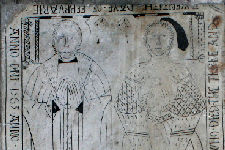The Church Monuments
The South Porch
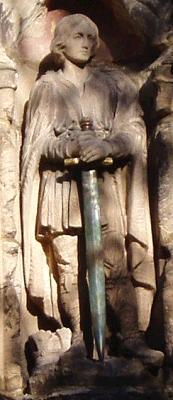 The figure of St Wystan over the porch door was the gift of the Rev'd S. B. Stallard-Penoyre in 1911. His sword, which had disappeared many years before, was given in 2003 in memory of Douglas Carr by his widow Pamela.
The figure of St Wystan over the porch door was the gift of the Rev'd S. B. Stallard-Penoyre in 1911. His sword, which had disappeared many years before, was given in 2003 in memory of Douglas Carr by his widow Pamela.
The porch contains the tombstone of an ecclesiastic (possibly one of the priors of Repton), a small 13th century coffin stone, and (in the roof) the "listening monk" carved by Miss Kidd.
Among the carved stones in the porch is an Anglo-Saxon cross-shaft of special merit, with delicate human figures and foliage. It is said to have been brought here from Ingleby a few miles away to the east, beside the River Trent.
On the floor nearby stands a rectangular stone, hollowed out below to form a window-head. Two larger and rather rougher window-heads lie beside a tomb fifteen yards south-west of the porch.
Two tall circular columns stand by the south doorway. Until 1854 these columns supported the east ends of the round arches at the eastern end of the side walls of the nave.
The Church
Inside the church, many ancient memorials have been destroyed in the past, and others ruthlessly mutilated.
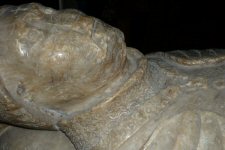 The oldest monument remaining is a full-length alabaster effigy of a recumbent knight in armour, lying on a tomb chest beside the north stairway to the crypt. At one time it surmounted an altar tomb at the East end of the north aisle, but in 1792 the tomb was broken up and the effigy laid on bricks in the crypt. The figure has been considerably damaged, and in addition has suffered extensive graffiti, this probably at the hands of Repton boys before the building of the school chapel. It was moved to its present position in 1911.
The oldest monument remaining is a full-length alabaster effigy of a recumbent knight in armour, lying on a tomb chest beside the north stairway to the crypt. At one time it surmounted an altar tomb at the East end of the north aisle, but in 1792 the tomb was broken up and the effigy laid on bricks in the crypt. The figure has been considerably damaged, and in addition has suffered extensive graffiti, this probably at the hands of Repton boys before the building of the school chapel. It was moved to its present position in 1911.
The figure has been thought to represent Sir Robert Fraunceys, who settled at Foremark towards the end of the 14th century. However, the 'suns and roses' collar with a pendant of the Lion of March indicates support for the House of York during the Wars of the Roses; Sir Robert died in 1420, long before a widespread Yorkist faction had developed, and decades before the Yorkist accession to the throne. A more likely candidate is Sir Robert's son, also Robert, who died about 1463, but the Lion of March pendant would be an extremely early example, and in any case, the armour appears to date from a later period. It is likely, therefore, that the tomb is that of Robert's son Thomas, who died in 1482. The Fraunceys were closely connected with the Fitzherberts, and it was through Nicholas Fitzherbert's marriage to Robert's daughter - Thomas' stepsister - that Nicholas was to inherit Tissington, where his descendants still reside.
The alabaster slab to Gilbert Thacker, now hanging on the wall of the South aisle, originally formed the covering stone of a tomb in the Thacker Quire, at the East end of the North aisle. When the floor level was raised in 1792, it was covered until 1854, when it was placed in its present position. Incised on the slab are the figures of Gilbert Thacker, who died in 1563, his wife, two children, and a dog. Thacker was responsible for pulling down the Priory Church and most of the monastic buildings. He had inherited them from his father, Thomas, who as Thomas Cromwell's steward at the time of the dissolution of the monasteries, had obtained possession of the Priory as his share of the spoil.
On the east wall of the north aisle is a monument to a later member of the same family, Francis Thacker, of Lincoln's Inn, who died in 1710. (Misleadingly, various graffiti, of which the clearest is 'I. Scott, 1774', have been incised on the plinth.)
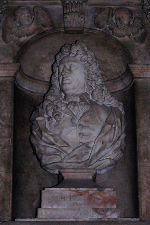 In his Historical and Topographical Description of Repton, in the County of Derby' Bigsby provides a description and commentary for "this chief and presiding ornament of the church":
In his Historical and Topographical Description of Repton, in the County of Derby' Bigsby provides a description and commentary for "this chief and presiding ornament of the church":
At the east end of the north aisle is a large and stately, though somewhat heavy-looking, mural monument of alabaster, in memory of Francis Thacker, Esq., of Lincoln's Inn. Within a canopied niche, in the centre of the design, is a bust, representing the deceased in a closely-buttoned coat, with a barrister's robe thrown over it, a close-drawn cravat; and a long curled peruke descending to the shoulders. On either side of the niche is a portion of upright scroll-work, embellished with a variety of fruits and flowers, ears of corn, palm-branches, and other objects, which are tastefully disposed, and skilfully executed. The niche is adorned with Corinthian pillars, that support an elegant cornice, whereon stand two urns, ornamented with festoons of drapery. Between the urns are armorial bearings of Thacker.
Above the altar in the north aisle is a monument to Thomas Fisher, who died in 1771, and his wife, Mary, who died in 1774. In the floor close to the altar is a large slate grave cover for them both. Geoffrey Fisher, former Headmaster of Repton School and Archbishop of Canterbury, was a descendant.
High up on the south wall of the south chapel is a memorial to George Waklin of Bretby, who died in 1617, and Ellen his wife, who died in 1614. The monument shows them kneeling face to face at a prayer desk with a child, their son, kneeling on a cushion below. This monument had occupied other positions in the church before it was placed here. Dr. Cox says it was stripped of many of its accessories and otherwise maltreated in 1854.
A tablet on the north wall of the north aisle records the death in 1847 of Elizabeth Bigsby, the wife of the historian to whom we are indebted for much of the information about the alterations to the church in 1792.
On the west wall, to the south of the tower arch, a memorial tablet records the death in 1850 of Richard Bull, who had sung in the choir for more than sixty years. Its position - so high that it is difficult to read - is a reminder that the singers' gallery - removed in 1885 - ran at this level across the west of the nave.
Repton School Headmasters and staff
Four former headmasters of Repton School are commemorated - William Prior, 1779, William Bagshaw Stevens, 1800, J. H. Macaulay, 1840, and W. B. Sleath, 1842, as well as Thomas Whitehead, First Usher, 1654, and A. F. E. Forman, for 30 years an assistant master, 1905. Macaulay is worth special mention. Headmaster from 1832 to 1840, his monument in the Fynderne Chapel speaks of his 'strict, but kind administration of his trust' and 'the respect and affection of his scholars'. This is perhaps charitable; elsewhere he is described as 'a big, bullying man, a strict disciplinarian and ferocious flogger'. News of his fatal illness brought the pupils to riot, breaking bounds 'in order to get hold of cakes and ale'. When news reached them that Macaulay was beyond hope, the boys smashed the furniture in his rooms and burned it on a bonfire.
Others
Further memorial tablets commemorate other members of the Thacker family,two former vicars, Joseph Jones, 1856, and A. A. McMaster, 1911.
The arms of George III over the south door date from the time when churches were obliged to display the monarch's coat of arms. They hung over the chancel arch from 1772 to 1885.
Archaeology
Significant archaeological finds have been made in excavations around the church. Some, including the 'Repton Stone', are in Derby Museum, some, including the Viking sword, in the British Museum. There are replicas of both the stone and the sword in Repton School Museum.
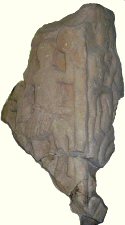
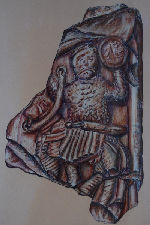 The Repton Stone was found in 1979 close to the eastern wall of the crypt. Of local sandstone it is a fragment of an 8th century standing cross shaft. On one face is depicted a sword- and shield-wielding horseman in mail armour, thought to be King Aethelbald of Mercia who died in 757 and was entombed in the crypt. As such, it would be the earliest large-scale pictorial representation of an English monarch. A second face represents the mouth of hell: a monster with human head and serpent's body devours two human figures dressed in knee-length breeches with cross-gartered legs.
The Repton Stone was found in 1979 close to the eastern wall of the crypt. Of local sandstone it is a fragment of an 8th century standing cross shaft. On one face is depicted a sword- and shield-wielding horseman in mail armour, thought to be King Aethelbald of Mercia who died in 757 and was entombed in the crypt. As such, it would be the earliest large-scale pictorial representation of an English monarch. A second face represents the mouth of hell: a monster with human head and serpent's body devours two human figures dressed in knee-length breeches with cross-gartered legs.
A picture of the Repton Stone hangs in the church.
Copy of 9th century gravestone
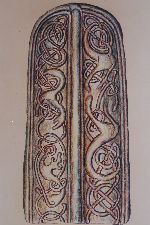 On the west wall of the nave, to the south of the tower arch hangs a copy of an early 9th century gravestone, the original now being in Derby Museum. A picture hangs nearby.
On the west wall of the nave, to the south of the tower arch hangs a copy of an early 9th century gravestone, the original now being in Derby Museum. A picture hangs nearby.
